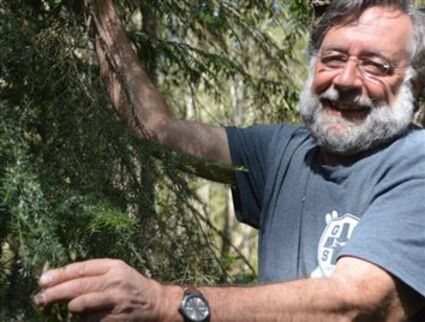Mark Whitmore is on a journey to save east coast hemlocks
Call him fuzz buster: he collects insect predators
April 21, 2021

LOCAL BOY RETURNS HOME TO SAVE EASTERN HEMLOCKS – Cornell University entomologist Mark Whitmore, a native of Buckley, Washington has made La Conner his base since January while scouring the north Puget Sound region for the hemlock woolly adelgid (HWA) an aphid-like, invasive insect. He sends branches of infested hemlocks east so the HWA’s predators can be harvested and grown to become a biological control released to save eastern hemlocks. – Photo by Ken Stern
Driving or walking on Flagstaff Lane, off Snee Oosh Road near Kukutali Preserve, or walking the preserve, you may notice white fuzz on the underside of western hemlock tree branches, or you may not. But Mark Whitmore always notices. He has been hunting this fuzz, the hemlock woolly adelgid (HWA), an aphid-like invasive insect since January, a mission that has brought him from New York state the last 15 years. He lops and harvests infested branches and ships them back to his lab in New York.
The HWA is a west coast native but on the east coast is an exotic, imported over 100 years ago on Japanese hemlock nursery stock. There are no natural predators to it on the east coast. Since the 1970s it has killed countless millions of hemlocks, spreading south to northern Georgia and north into New York, New England and Nova Scotia.
Whitmore, a forest entomologist from Cornell University, has based himself in La Conner since January, when he and his partner and assistant Julie Kulik could not find housing in Mount Vernon. “Quite frankly, I love it here. It is centrally located for me,” he said. He has found the majority of HWA in north Puget Sound, venturing to Whidbey Island and the Olympic Mountains. He made a productive trip to northern California in late March, but did not find large populations in Oregon.

“Timing is everything with predators for life cycles,” Whitmore notes. “Collecting in California and Washington widens the range. It is all temperature related. Development is earlier in California.”
The insects hatch in a larval form dubbed “crawlers,” which move along the tree to find a feeding site. Then they proceed through four nymphal stages as they feed in place on the tree. They damage trees by sucking nutrients from them. Whitmore describes their morphology, with their piercing, sucking mouth parts, as “a balloon with straw-like mouth parts that go into the twig.”
One of the reasons they are such a problem is that they reproduce asexually. There are only females, Whitmore said.
Hemlock trees on the west coast suffer little damage from HWA. Here the insect has many predators, with three highly specific, a beetle and two silver flies, that are used as biological control in the east.
Whitmore is after all three. “Like most things in life, you can’t focus on one thing and expect it to work” he explains. “You have to diversify. That’s why I came out here. It is serendipitous that I grew up here and know the area like the back of my hand.”

He is the right person for the job. His family’s roots are in Buckley, on Mount Rainier’s slopes. He worked as a logger, then for the Forest Service to put himself through college, going to Western Washington University. He went to the University of Washington for his forestry masters then down to the University of California at Berkeley to study biological control of forest insects.
He reflects “Not very many people can do what I do. I know the country and I see these little things growing on trees. My whole life I have been looking at trees. Now someone pays me to do it. How goofy is that?” Now he says he “drives around and think about bugs and hemlocks and talk to Julie on occasion. I catch this (an infestation) out of the corner of my eye going 60 mph and I circle back.”
He is looking for high concentrations of HWA, for where the white fuzz is so are its predators. Whitmore views it as “sort of like a game of whack-a-mole. HWA starts in small populations that expand. As they grow, predator populations grow. My whole thing is to chase HWA like a crazy man, looking for dense HWA, which then disappears because of the predators. At the time HWA are growing at other places, like whack-a-mole. I have a database of locations.” He pointed to an upper branch of a tree on Flagstaff Lane. “You can see the white dots.”
He is looking for, he says “a 1 mm ball of spit that feeds on the twig of hemlocks. It produces a wooly coat that protects it from the elements.”
Last Friday, he made a discovery, perhaps coincidentally, around Buckley, finding a populations at 2,700 feet elevation; uniquely high.
He cuts out the foliage, collecting it initially in plastic garbage bags. He has permits to handle and ship containers to his lab at Cornell by Federal Express. His staff quarantine the predator species and raise the insects to adults for experimental use until released in New York forests.
The two Pacific northwest species of hemlocks are widespread growing from sea level to the tree line. On the east coast there are few conifers, Whitmore says. Hemlocks are a foundational species forming an irreplaceable habitat, critical for a myriad of species to survive: migrating birds, mammal in winter, trout needing cool water and they are an iconic landscape.
Success is not certain. As an invasive species, HWA, populations grow unchecked. In the Great Smokey Mountain National Park 10 years after HWA invaded all hemlocks not treated with insecticides were dead. Whitmore repeated “countless millions of trees have died” more than once.
The U.S. Forest Service started a program of implementing biological controls in the 1990s. It is part of long term management strategy. Whitmore notes that “there is not a whole lot of success with biological control. That’s the hard part. Trees are long living organisms. They spread across the landscape.” Yet forests cover such huge acreages that chemicals are not a solution.
“We are seeing results, but a smashing success has yet to be seen,” he reflected. “If you don’t hope you don’t get anywhere. If you don’t hope what do you get?”




Reader Comments(0)